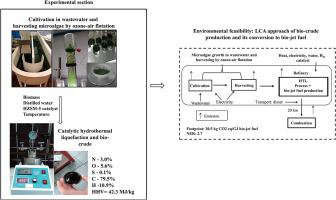Energy Conversion and Management ( IF 9.9 ) Pub Date : 2021-10-14 , DOI: 10.1016/j.enconman.2021.114806 I. Nava-Bravo 1 , S.B. Velasquez-Orta 2 , I. Monje-Ramírez 1 , L.P. Güereca 1 , A.P. Harvey 2 , R. Cuevas-García 3 , I. Yáñez-Noguez 1 , M.T. Orta-Ledesma 1

|
The use of ozone-air flotation for microalgae harvesting was investigated, in terms of its environmental feasibility and use in catalytic HTL. The environmental feasibility was determined by the Net Energy Ratio (NER) and carbon footprint metrics following a life cycle assessment (LCA). The effect of the variables in the catalytic HTL process (catalyst load, temperature, time), on the distribution of bio-crude and hydrocarbons, was experimentally evaluated using a mixed microalgae culture dominated by Scenedesmus sp. grown in wastewater and harvested by ozone-air flotation or gravity-sedimentation, respectively. Liquefaction was carried at three temperatures (325 °C, 350 °C and 370 °C), three reaction times (30, 60 and 120 min) and two HZSM-5 catalyst loads (0, 5 and 7 wt%). The bio-crude yields obtained (17 to 20%) were similar with both harvesting methods; however, the production of aliphatic compounds was doubled, when using ozone-air flotation, and further increased when using a HZMS-5 catalyst. The highest bio-crude quality (N: 3.0%, O: 5.6%, S: 0.1%) and high heat values (42.3 MJ/kg) were produced at 325 °C, 60 min and 5 wt%, in contrast with sedimented microalgae (6.0%, 7.0%, 1.0%, and 39.3 MJ/kg, respectively). Energy and carbon footprint were quantified with a LCA approach for a scenario using a functional unit (FU) of 1 GJ of bio-crude production and its possible bio-jet fuel conversion as a potential product. HTL microalgae conversion required the highest amount of energy among evaluated cultivation and harvesting processes. Harvesting via ozone-air flotation, gave a NER value and carbon footprint of 2.7 and 30.5 kg CO2 eq/GJ of bio-jet fuel, respectively. The proposed novel system had significantly lower greenhouse gas equivalent emissions (by 65%) and NER values (by 48%) than for conventional jet fuel.
中文翻译:

废水中微藻的催化水热液化:臭氧气浮对产品、能量平衡和碳足迹的影响
就其环境可行性和催化 HTL 中的用途而言,研究了臭氧-气浮在微藻收获中的使用。环境可行性由净能量比 (NER) 和生命周期评估 (LCA) 后的碳足迹指标确定。使用以栅藻为主的混合微藻培养实验评估了催化 HTL 过程中变量(催化剂负载、温度、时间)对生物原油和碳氢化合物分布的影响sp. 分别在废水中生长并分别通过臭氧气浮或重力沉降收集。液化在三个温度(325°C、350°C 和 370°C)、三个反应时间(30、60 和 120 分钟)和两种 HZSM-5 催化剂负载(0、5 和 7 wt%)下进行。两种收获方法获得的生物原油产量(17% 至 20%)相似;然而,当使用臭氧气浮时,脂肪族化合物的产量增加了一倍,而在使用 HZMS-5 催化剂时进一步增加。与沉积物相比,在 325 °C、60 分钟和 5 wt% 的条件下产生最高的生物原油质量(N:3.0%,O:5.6%,S:0.1%)和高热值(42.3 MJ/kg)微藻(分别为 6.0%、7.0%、1.0% 和 39.3 MJ/kg)。能源和碳足迹通过 LCA 方法量化,用于使用 1 GJ 生物原油生产的功能单元 (FU) 及其可能的生物喷气燃料转换作为潜在产品。在评估的培养和收获过程中,HTL 微藻转化需要最高的能量。通过臭氧气浮收集,获得 NER 值和 2.7 和 30.5 kg CO 的碳足迹分别为 2 eq/GJ 的生物喷气燃料。与传统喷气燃料相比,提议的新型系统的温室气体当量排放量(降低 65%)和 NER 值(降低 48%)显着降低。











































 京公网安备 11010802027423号
京公网安备 11010802027423号